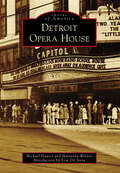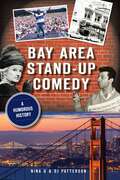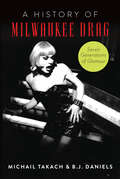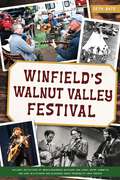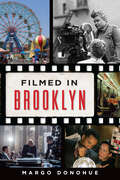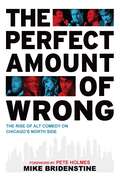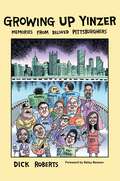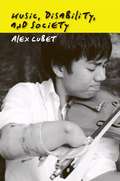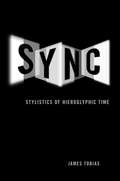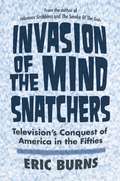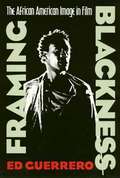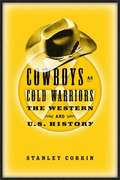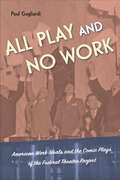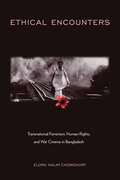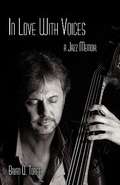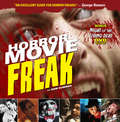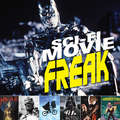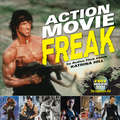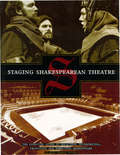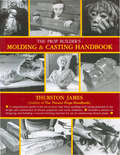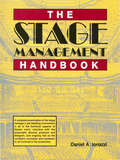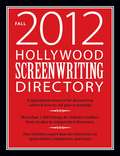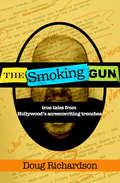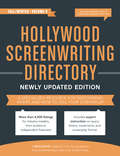- Table View
- List View
Detroit Opera House (Images of America)
by Marianne Weldon Michael HauserThe theater known today as the Detroit Opera House has been an integral part of the city's culture and history as well as the live entertainment industry. Its existence has been threatened in the past, but it has survived wars, the Great Depression, civil unrest, economic meltdowns, the abandonment of downtown, and, most recently, a pandemic. Generations of patrons have fond, vivid memories of attending films, stage presentations, or events with family and friends as it transitioned from the Broadway Capitol to the Paramount to the Grand Circus to the Detroit Opera House. The reason for building these "temples of amusement" was to literally transport a guest into another world, and the Detroit Opera House has valiantly fulfilled that task. What began as an idea by David DiChiera, founder of Michigan Opera Theatre, the owner and operator of today's Detroit Opera House, blossomed into a magnificent performing arts center with its formal opening in 1996.
Bay Area Stand-Up Comedy: A Humorous History
by Nina G OJ PattersonComedians of the San Francisco Bay Area changed comedy forever.From visiting acts like Richard Pryor, Steve Martin and Whoopi Goldberg to local favorites who still maintain their following and legacy, the Bay Area has long been a place for comedians to develop their voice and hone their stand-up skills. Popular spots included Cobb's, the Purple Onion, Brainwash, and the holy grail of San Francisco comedy during the 1980s boom, the Holy City Zoo. For over seventy years, these iconic venues and others fostered talent like Ali Wong, Moshe Kasher and the Smothers Brothers, introducing them to local crowds and the world beyond.Join comedians Nina G and OJ Patterson on a hilarious and thoughtful tour through the history of Bay Area comedy.
History of Milwaukee Drag, A: Seven Generations of Glamour (American Heritage)
by Michail Takach BJ Danielsp>The queens that made Milwaukee famousFor over a century, drag has been an unstoppable force in Milwaukee nightlife. On June 7, 1884, "The Only Leon" brought the fine art of female impersonation to the Grand Opera Hall, launching a proud local legacy that continues today at This Is It, La Cage, Hamburger Mary's, D.I.X. and innumerable other venues.Historians Michail Takach and BJ Daniels recognize that today's LGBTQ liberties were born from the strength, resilience, and resistance of yesterday's gender non-conforming pioneers. This is a long overdue celebration of those stories, including high-rolling hustler of the Fourth Ward "Badlands" Frank Blunt, over-the-top dinner theater drag superstar of the 1950s Adrian Ames, and "It Kid" Jamie Gays, first-ever Miss Gay Milwaukee and Latin community hero.And many, many more.
Hollywood Tiki: Film in the Era of the Pineapple Cocktail
by Adam Foshko Jason HendersonIsland Escapes, South Seas Adventures, and Musical Surf Parties of Midcentury CinemaTiki Culture arose as the defining expression of American pop culture during World War II and its influence continued through the 1960s. The essence of Tiki featured heavily in films of the era, depicting palm-tree and cocktail-laden escapes that captivated audiences nationwide. Films like South Pacific and The Man in the Gray Flannel Suit were a hodgepodge of jungle imagery and World War II Pacific theater memories. A fascination with the new State of Hawaii was reflected in Elvis's Blue Hawaii, while balmy youth flicks like Beach Blanket Bingo and Gidget showcased surf, sun and fun.Join authors Jason Henderson and Adam Foshko as they explore films about the experiences of war filtered through the tropical splendor that defined an era.
Winfield's Walnut Valley Festival
by Seth Bate Dan Crary Beppe Gambetta John McCutcheon Orin FriesenLocal historian Seth Bate tells the story of the Walnut Valley Festival with reflections from staff, emcees, performers, campers, and characters from throughout its history.The Festival was launched in 1972 when a guitar maker, a farmer, and a businessman built their own music festival from the ground up. It has made the small town of Winfield into an annual destination for acoustic musicians and music lovers from around the world and it has always been participatory, with the informal campsite pickin' as much a part of the event as the stage shows and instrumental contests. The Walnut Valley Festival has always been proud of its deep-rooted traditions, but most of all, it is a community celebration.
Filmed in Brooklyn
by Margo Donohue"Shooting in Brooklyn is like opening a time capsule. Nothing has changed. Everything looks like it did in the eighties." -Freddie Prinze, Jr. Discover the iconic films, legendary personalities and the locations for timeless big screen moments that took place in Brooklyn. From Saturday Night Fever to numerous Spike Lee Joints, readers can learn about Brooklyn's cinematic past or discover locations to visit today.
The Perfect Amount of Wrong: The Rise of Alt Comedy on Chicago's North Side (The History Press)
by Mike BridenstineIn just over a decade, a tiny, do-it-yourself stand-up scene on the North Side of Chicago produced some of the most successful and influential stand-up comedians of their generation. Hannibal Buress, T.J. Miller, Kyle Kinane, Cameron Esposito, Pete Holmes, Beth Stelling, Matt Braunger and Kumail Nanjiani make up a partial list of names of comics who emerged from a scene that had very little industry attention--or even a home club. It was also a scene that took a backseat to the city's vaunted improv institution, and if we're being completely honest, it was a scene where comics mostly performed to drunks in the backs of dingy bars on their off nights. None of it was glamorous. None of it should have worked at all. But somehow, some way, the comedians from this scene have managed to etch their own names into the Chicago comedy pantheon. The Perfect Amount of Wrong is the story of that scene, as told by its veterans.
Growing Up Yinzer: Memories from Beloved Pittsburghers (The History Press)
by Dick RobertsIn the Steel City, "Yinzer" is a term of endearment, reserved for the city's most beloved and embraced by locals as a symbol of the grit and determination that Pittsburgh endows anyone from there. The city's undeniable impact on the character and life of those who grew up there has shaped iconic figures of American sports, entertainment and culture. Legends of the gridiron such as Jim Kelly, Tony Dorsett, Dan Marino and Joe Namath forged their football prowess in Western Pennsylvania. Business pioneers including Mark Cuban, Ray Werner and Bill Strickland were ingrained with the value of hard work in the Steel City. Music and movie stars like Jeff Goldblum, George Benson and Billy Gardell found creative inspiration in Pittsburgh that led to new heights. Author Dick Roberts presents profiles, interviews and memories from some of the most famous and adored Pittsburghers.
Music, Disability, and Society
by Alex LubetMusical talent in Western culture is regarded as an extraordinary combination of technical proficiency and interpretative sensitivity. In Music, Disability, and Society, Alex Lubet challenges the rigid view of technical skill and writes about music in relation to disability studies. He addresses the ways in which people with disabilities are denied the opportunity to participate in music. Elaborating on the theory of "social confluence," Lubet provides a variety of encounters between disability and music to observe radical transformations of identity. Considering hand-injured and one-handed pianists; the impairments of jazz luminaries Django Reinhardt, Horace Parlan, and "Little" Jimmy Scott; and the "Blind Orchestra" of Cairo, he shows how the cultural world of classical music contrasts sharply with that of jazz and how musicality itself is regarded a disability in some religious contexts. Music, Disability, and Society also explains how language difference can become a disability for Asian students in American schools of music, limiting their education and careers. Lubet offers pungent criticism of the biases in music education and the music profession, going so far as to say that culture disables some performers by adhering to rigid notions of what a musician must look like, how music must be played, who may play it, and what (if any) is the legitimate place of music in society. In Music, Disability, and Society, he convincingly argues that where music is concerned, disability is a matter of culture, not physical impairment.
Sync: Stylistics of Hieroglyphic Time
by James TobiasIn Sync, James Tobias examines the development of musical sound and image in cinema and media art, indicating how these elements define the nature and experience of reception. Placing musicality at the center of understanding streaming media, Tobias presents six interwoven stories about synchronized audiovisual media—from filmmaker Sergei Eisenstein’s Alexander Nevskyto today’s contemporary digital art and computer games—to show how these effects are never merely "musical" in the literal sense of organized sound.
Invasion of the Mind Snatchers: Television's Conquest of America in the Fifties
by Eric BurnsWhen the first television was demonstrated in 1927, a headline in The New York Timesread, “Like a Photo Come to Life. ” It was a momentous occasion. But the power of television wasn’t fully harnessed until the 1950s, when the medium was, as Eric Burns says, “At its most preoccupying, its most life-altering. ” And Burns, a former NBC News correspondent who is an Emmy-winner for his broadcast writing,knows about the impact of television. Invasion of the Mind Snatcherschronicles the influence of television that was watched daily by the baby boomer generation. As kids became spellbound by Howdy Doodyand The Ed Sullivan Show,Burns reveals, they often acted out their favorite programs. Likewise, they purchased the merchandise being promoted by performers, and became fascinated by the personalities they saw on screen, often emulating their behavior. It was the first generation raised by TV and Burns looks at both the promise of broadcasting as espoused by the inventors, and how that promise was both redefined and lost by the corporations who helped to spread the technology. Yet Burns also contextualizes the social, cultural, and political events that helped shape the Fifties-from Sputnik and the Rosenberg trial to Senator Joseph McCarthy’s Red Scare. In doing so, he charts the effect of television on politics, religion, race, and sex, and how the medium provided a persuasive message to the young, impressionable viewers.
Framing Blackness: The African American Image in Film
by Edward GuerreroHow African-Americans are depicted in movies.
Cowboys as Cold Warriors: The Western and U.S. History
by Stanley CorkinThough the United States emerged from World War II with superpower status and quickly entered a period of economic prosperity, the stresses and contradictions of the Cold War nevertheless cast a shadow over American life. The same period marked the heyday of the western film. Cowboys as Cold Warriors shows that this was no coincidence. It examines many of the significant westerns released between 1946 and 1962, analyzing how they responded to and influenced the cultural climate of the country. Author Stanley Corkin discusses a dozen films in detail, connecting them to each other and to numerous others. He considers how these cultural productions both embellished the myth of the American frontier and reflected the era in which they were made. Films discussed include: My Darling Clementine, Red River, Duel in the Sun, Pursued, Fort Apache, Broken Arrow, The Gunfighter, High Noon, Shane, The Searchers, Gunfight at the OK Corral, The Magnificent Seven, The Alamo, Lonely Are the Brave, Ride the High Country, and The Man Who Shot Liberty Valance.
All Play and No Work: American Work Ideals and the Comic Plays of the Federal Theatre Project
by Paul GagliardiMany of the Federal Theatre Project (FTP) plays Paul Gagliardi analyzes in All Play and No Work feature complex portrayals of labor and work relief at a time when access to work was difficult. Gagliardi asks, what does it mean that many plays produced by the FTP celebrated forms of labor like speculation and swindling? All Play and No Work directly contradicts the promoted ideals of work found in American society, culture, and within the broader New Deal itself. Gagliardi shows how comedies of the Great Depression engaged questions of labor, labor history, and labor ethics. He considers the breadth of the FTP’s production history, staging plays including Ah, Wilderness!, Help Yourself, and Mississippi Rainbow. Gagliardi examines backstage comedies, middle-class comedies, comedies of chance, and con-artist comedies that employed diverse casts and crew and contained radical economic and labor ideas. He contextualizes these plays within the ideologically complicated New Deal, showing how programs like the Social Security Act straddled progressive ideals and conservative, capitalist norms. Addressing topics including the politicization of theatrical labor and the real dangers of unchecked economic con artists, the comic plays of the FTP reveal acts of political resistance and inequality that reflected the concerns of their audiences.
Ethical Encounters: Transnational Feminism, Human Rights, and War Cinema in Bangladesh
by Elora Halim ChowdhuryEthical Encounters is an exploration of the intersection of feminism, human rights, and memory to illuminate how visual practices of recollecting violent legacies in Bangladeshi cinema can conjure a global cinematic imagination for the advancement of humanity. By examining contemporary, women-centered Muktijuddho cinema—features and documentaries that focus on the Bangladesh Liberation War of 1971—Elora Chowdhury shows how these films imagine, disrupt, and reinscribe a gendered nationalist landscape of trauma, freedom, and agency. Chowdhury analyzes Bangladeshi feminist films including Meherjaan, and Itihaash Konna (Daughters of History), as well as socially-engaged films by activist-filmmakers including Jonmo Shathi (Born Together), and Shadhinota (A Certain Liberation), to show how war films of Bangladesh can generate possibilities for gender justice. Chowdhury argues that justice-driven films are critical to understanding and negotiating the layered meanings and consequences of catastrophic human suffering yet at the same time they hint at subjectivities and identities that are not reducible to the politics of suffering. Rather, they are key to creating an alternative and disruptive archive of feminist knowledge—a sensitive witnessing, responsible spectatorship, and just responsibility across time, and space. Drawing on Black and transnational feminist critiques, Chowdhury explores questions around women’s place, social roles, and modes of participation in war as well as the visual language through which they become legible as victims/subjects of violence and agents of the nation. Ethical Encounters illuminates the possibilities of film as a site to articulate an ethics that acknowledges a founding violence of the birth of a nation, recuperates it even if in fragments, and imagines differently the irreconcilable relationship between humanity, liberty, and justice.
In Love With Voices: A Jazz Memoir
by Brian Q. TorffIn his memoir, Torff takes us beyond the music by adding depth with his vision of American music, and paints vivid portraits of the musicians with whom he played.
Horror Movie Freak
by Don SumnerYou'll scream with delight while reading this fun and engaging book that discusses fright flicks all horror fans need to see to ascend to the level of a true Horror Freak -from classics (Dracula and Psycho) to modern movies (Drag Me to Hell) and lesser-known gems (Dog Soldiers). Movies are divided into various categories including Asian horror, beginners, homicidal slashers, supernatural thrillers, and zombie invasion. Features more than 130 movies, 250+ photos of movie stills and posters, and a chapter on remakes and reimaginings. The book also includes the DVD of George A. Romero's original 1968 version of "Night of the Living Dead."
Sci-Fi Movie Freak
by Robert C. Ring"I'll be back." -- The Terminator, The Terminator (1984) To the movies, that is. And so will you with the help of Sci-Fi Movie Freak, a celebration of some of the greatest science-fiction movies of all time. Your inner geek will freak finding everything from classics like Metropolis, Forbidden Planet, and 2001: A Space Odyssey to modern movies including Avatar, Moon, and Inception, and even the entertaining "failures" like Robot Monster, Gammera the Invincible, and Battlefield Earth. Movies are divided into various chapters including Best of the Best, Further Essentials, and Lesser-Known Gems. Features more than 100 movies 250+ photos of movie stills and posters Top 10 lists of the best directors, female characters, villains and moreFree DVD included of the magnificently bad cult classic Plan 9 From Outer Space.
Action Movie Freak
by Katrina HillWritten by woman of action Katrina "Action Flick Chick" Hill, Action Movie Freak is packed with spine-tingling excitement and thrilling moments that make action movies a beloved genre for those who crave crashing cars, exploding buildings, and faces getting kicked six ways to Sunday. With badass heroes that ain't got time to bleed, women warriors, thrilling chases and outrageous fisticuffs, Action Movie Freak celebrates a wide variety of more than 100 movies that have left audiences on the edge of their seats. Complete movie reviews are divided into various sub-genres including Classics That Defined the Genre (The Bond movies of the 1960s, "Bullit," "Dirty Harry") Bloodiest Action Movies ("Ninja Assassin," "Rambo" series, "RoboCop") and Action From the Far East ("Bangkok Knockout," "Ong Bak," "Ip Man"). The book also spotlights specific action heroes/actors, and features 250 color photos and movie posters, as well as fun Top 10 lists, including best one-liners and most over-the-top kills.
Staging Shakespearean Theatre: The Essential Guide to Selecting, Interpreting, Producing and Directing Shakespe are
by Elaine NovakFrom auditions and rehearsals to publicity, this guide leads even inexperienced directors, producers, choreographers and actors through the complicated and sometimes fearsome task of staking Shakespeare. Comprehensive information is presented in a browsable format including historical background of the Elizabeth period, descriptions of major plays, a glossary of terms, suggestions for modern interpretations, step-by-step instruction for choreographing fight scenes, and a full treatment of Romeo & Juliet
The Prop Builder's Molding & Casting Handbook (Technical Theatre, Film And Television Ser.)
by Thurston JamesThe Prop Builder's Molding & Casting Handbook This is the first book to contain, in one comprehensive volume, every molding and casting procedure of use to the theater props builder (no matter what his or her level or proficiency). The author demonstrates the techniques involved in using more than thirty different materials ranging from papier-mache to breakaway glass. While the use of some materials–plaster and polyester resins, for example–is covered to some extent in other publications, information on the selection and use of rubber materials (latex, neoprene, silicone, and the urethanes) and the procedure for making breakaway windows and bottles is available only in The Prop Builder's Molding & Casting Handbook. Written in an easy, conversational style, the book will be useful to anyone involved with theater properties, puppetry, and costuming (as professionals or amateurs). It will also serve admirably the needs of students taking classes in those subjects. Completing the book is a special section on designing and building a vacuum forming machine suitable for use in constructing theater props. More than 450 photographs illustrate the step-by-step procedures explained throughout the entire text.
The Stage Management Handbook
by Daniel A. IonazziThe stage manager is the renaissance man of the theater. He or she must have a working knowledge of how the various technical aspects of the theater work (scenery, props, costumes, lights and sound), be part director, part playwright, part designer and part producer, and be prepared to act as confidant, counselor and confessor to everyone else in the company. This book addresses all of these considerations in detail and offers the reader–professional or amateur, veteran or beginner–helpful guidance and practical advice, supported by many forms and examples to illustrate the points covered in the text. The three phrases of mounting and performing a show are covered. Part I takes the reader through the pre-production phase–research, the script, planning and organization, and auditions. Part II covers the rehearsal process–rehearsal rules, blocking, cues, prompting, information distribution, technical and dress rehearsals. Part III discusses the performance phase–calling the show, maintaining the director's work, working with understudies and replacements, and more. Part IV provides insights into the organizational structure or some theaters and aspects of human behavior in those organizations. Many stage managers of long-running commercial productions believe that–once the show is up and running–only ten percent of their work is related to everything covered in Parts I, II and III. The other ninety percent is associated with issues in Part IV; i.e. "managing" human behavior and maintaining working relationships.
Hollywood Screenwriting Directory: A Specialized Resource for Discovering Where & How to Sell Your Screenplay
by The Writers Storedirectory
The Smoking Gun
by Doug RichardsonWhat do you know, really?Sure. Having enough talent to act, direct, or write a screenplay is one set of skills. But navigating both the main streets and back alleys of Hollywood cannot be done with GPS. Ride shotgun with screenwriting and producing veteran Doug Richardson as he skillfully - yet so amusingly - lives, dies, survives, and thrives in the entertainment trenches.The Smoking Gun is more than a collection of true Hollywood stories, box office success and jaw-dropping failures. It's a guided tour behind the curtain of an industry that is equal parts bright lights, backstabbing, and double-dealing. Buckle up, step into your steel jockstrap, and get ready to do battle in the carnival funhouse otherwise known as showbiz.
Hollywood Screenwriting Directory Fall/Winter: A Specialized Resource for Discovering Where & How to Sell Your Screenplay
by Jesse Douma Dinah PerezTo get your screenplay in front of the right buyer, you need exclusive information and specific details you can only gain through years of industry experience. That's why The Writers Store has compiled the Hollywood Screenwriting Directory, the product of more than three decades working directly with the decision makers behind the world's favorite films. This invaluable reference features:Thousands of listings for Hollywood buyers, industry insiders, studios, and independent financiers, all with verifi ed contact informationCrucial details for submitting your screenplay to specific markets: how they prefer to receive submissions, and whether they accept unsolicited materialA guide to properly formatting your script and packaging your submissionClear, step-by-step instructions for crafting professional query letters, treatments, and log linesA Silver subscription to ScreenwritingDirectory.com (a $49 value)In addition, you'll find illustrated screenplay samples, essential legal information, and tips for creating a quality submission. With the Hollywood Screenwriting Directory at your fingertips, you'll significantly increase your chances of script-selling success!
